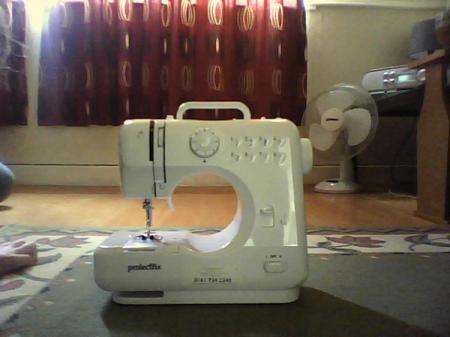My sewing machine won't sew and the loop from the spool is coming through the material, but the cotton from the reel is just threading through the loop without making a stitch. Also the cotton from the reel is very tight. What should I do?
By Carol

Add your voice! Click below to answer. ThriftyFun is powered by your wisdom!
Refer to your user manual to learn where your tension adjustment dials/knobs/control pad is located. The manual will have photos or line drawings with examples of the appearance of too tight or loose tension, and will tell you how to adjust the tension accordingly.
If you don't have the manual you can usually find a free download at the manufacturer's website. Google the maker's name and the model name/number of your machine to find the website. Then follow the navigation links to find your manual.
Generally, loops on the bottom means tension is too loose; loops on the top that the tension is too tight.
Most machines use a numbering system to adjust tension so use the following formula:
To increase (tighten) dial to a higher number
To decrease (loosen) dial to a lower number
Use a doubled over scrap of your fabric as a practice swatch to run several inches of the stitches for each increase/decrease you make to the tension adjustment; when you find the right setting for your fabric, write that setting down for further reference during that project.
You'll want to write down the tension setting because in sewing, tension adjustments will vary depending on the stitch used and the thickness of the fabric you want to stitch at any given point in the project.
For example, let's say you are going to use a simple zig-zag to finish the raw edges of the seams. To make a really nice pucker-free zig-zag edge finish you need to decrease (loosen) the tension slightly; to stitch through several layers if you are using a flat-fell finish you would want to adjust the tension to a looser setting also. Decide your best tension according to a practice swatch.
So you are best served to write all those different tensions for each stitch setting down-makes it so much faster and easier to keep track between the different sections of your project!
**Looping, bunching, snarling, and threads that can be easily pulled from the fabric do not always indicate a need to adjust tension. Ask yourself, "Before beginning sewing, did I...":
Check the manual to be sure I am using the correct thread and needle size for the fabric I am sewing?
Make sure my needle is in new or good condition, is sharp, and is correctly placed in the machine?
Ensure my bobbin thread is also the correct gauge and type for the fabric I am sewing?
Make sure my bobbin case is correctly placed into the machine?
Check that my machine is set for the stitch I want to use?
Look to see that the automatic tension feature (if on your model) set correctly?
Don't give up:) There is nothing quite as satisfying as sewing garments or home furnishings but it does take practice.
Add your voice! Click below to answer. ThriftyFun is powered by your wisdom!